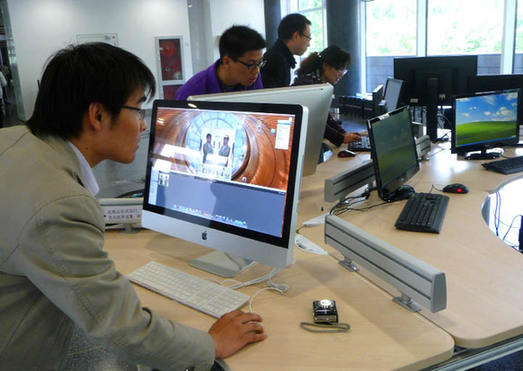| Chinese Universities Embracing the World
By staff reporter HOU RUILI
 The newly opened Kaifeng Humanities and Social Sciences Library of Tsinghua University.
The newly opened Kaifeng Humanities and Social Sciences Library of Tsinghua University.
TRAVELING to study in a foreign country was already popular as far back as ancient Greece. Globalization, and a consequently more integrated world, has intensified the internationalization of education. China is the world’s biggest exporter of commodities, and runner up in imports, with a GDP ranked second in the world. It now sets its sights on making big strides in educational reform and an impact on the market in human talent. In the universities of China, the functions of international cooperation and cultural exchange are going far beyond academics, scientific research, and social services.
Embracing the World: the Tradition in Education
After the Opium War in 1840, China became a semi-feudal, semi-colonial country. Its universities emerged in the late 19th century and early 20th, at a time when people believed in revitalizing the country through education. The government established Peiyang University (now Tianjin University), the Imperial University of Peking (now Peking University), Zhejiang University, and Soochow University. St. John’s University, Yenching University and Fu Jen Catholic University were established by Western missionaries. In addition, there were private universities set up by patriotic national entrepreneurs. Nankai University was one of them.
The nature and mission of these universities was somewhat diverse and encompassed international viewpoints. After Japan started its invasion of China in 1937, Peking, Tsinghua and Nankai universities merged into the National Southwest Associated University. The curriculum was similar to the one at Harvard University, and both emphasized balanced development of students. The National Southwest Associated University was regarded as the best in Asia, and the programmatic distinctions also bore similarities to those at Harvard; both were student-oriented.
After the founding of new China in 1949, higher education in China has experienced two dramatic changes.
The first was the adjustment of faculties in 1952. It replaced the former comprehensive system with the Soviet Union’s model, aiming to adapt to the planned economy approach used at the time, and the 156 projects sponsored in China by the Soviet Union. Zhang Xinsheng, Vice Minister of Education who took a graduate program in Urban Planning and Design at Harvard University, commented, “Though this model was characterized by an undergraduate program that was not very integrated, it fit the historical context. It helped China develop a comparatively integrated industrial and economic system, and establish a foundation for its education, science, culture, and health systems.” Due to Western blockade, exchanges between China and the West ceased. Exchanges and cooperation in education were mostly with the Soviet Union and Eastern Europe, so most Chinese students destined to study abroad were sent to these countries. From 1950 to 1965, 10,698 Chinese students were sent to the Soviet Union, Eastern Europe, DPRK, and some 20 other countries. Among them, 8,320 were sent to the Soviet Union, accounting for 78 percent of the total.
|

